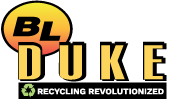
During the first week of each month, referred to as “The Buy,” our team negotiates with steel mills to secure purchase orders for all ferrous grades. The remaining three weeks are then focused on fulfilling these orders. Various factors, including supply and demand, mill outages, export demand, weather conditions, and the availability of freight and cost, impact these negotiations. At BL Duke, we prioritize shipping point pricing and take full advantage of our ability to ship materials via truck, rail, and barge.

As we enter April, the ferrous scrap market is showing clear signs of weakness, with a bearish outlook emerging both domestically and internationally. A combination of the softening busheling futures market, slowing export activity, rising inventory levels, and mounting trade policy uncertainty is contributing to a cautious, if not pessimistic, sentiment heading into the month.
Ferrous Market Trends
The ferrous market’s recent strength appears to be losing momentum. March brought modest price gains across the country—prime scrap rose by $20–40 per gross ton, and shredded scrap increased $10–30 per gross ton depending on the region. In Chicago, those increases have accumulated to roughly $100 per gross ton since the start of the year.
However, the tone has since shifted. Supply overhangs are becoming more evident, particularly in regions where mills limited their buy programs during the March trade. Many sellers report unsold tons, and some are concerned about softening demand heading into April. Additionally, shredder feed prices remain elevated due to earlier finished scrap gains, but flows remain inconsistent and well below optimal levels.
Slowing Turkish Import Activity
Export activity, particularly to Turkey, which had been a supportive factor in recent months, has now begun to slow. Turkish mills booked at least five US East Coast cargoes earlier in March, but recent transactions have come in at reduced prices—around $380 per tonne CFR for HMS 1&2 (80:20), and $400 per tonne for shredded scrap. The slight drop reflects waning buying appetite, as Turkish mills appear to be well-stocked for April shipments.
This slowdown comes at a time when Turkey’s steel trading environment is under additional strain. Beyond the typical seasonal lull associated with Ramadan, the country is also dealing with heightened political uncertainty. On March 19, Istanbul’s mayor, Ekrem İmamoğlu, was detained and later arrested as part of a high-profile corruption investigation. The incident came just as he was expected to announce his presidential candidacy and has since triggered political unrest, further unsettling investor and market confidence. These factors have disrupted both buying activity and pricing in Turkey’s steel and scrap markets, contributing to a pullback in import demand.
Tariffs: The Looming Unknown
 Adding another layer of complexity to the April outlook is the ongoing evolution of U.S. trade policy. The White House is expected to begin rolling out the next wave of trade and tariff actions starting Wednesday, April 2, as part of President Trump’s “America First” Trade Policy. These actions follow reviews by federal trade agencies and could include further clarification on Emergency Border Tariffs for imports from Canada, Mexico, and China, as well as guidance on the implementation of “reciprocal tariffs”—a new concept designed to match U.S. import duties to those imposed by trading partners.
Adding another layer of complexity to the April outlook is the ongoing evolution of U.S. trade policy. The White House is expected to begin rolling out the next wave of trade and tariff actions starting Wednesday, April 2, as part of President Trump’s “America First” Trade Policy. These actions follow reviews by federal trade agencies and could include further clarification on Emergency Border Tariffs for imports from Canada, Mexico, and China, as well as guidance on the implementation of “reciprocal tariffs”—a new concept designed to match U.S. import duties to those imposed by trading partners.
While Canada and Mexico currently enjoy exemptions for qualifying goods under USMCA rules, U.S. Customs and Border Protection has not issued an expiration date on those exemptions. Importantly, a 25% tariff on all automotive and auto parts imports from all countries will take effect at midnight on April 3, potentially impacting manufacturing sectors and downstream scrap demand in the coming weeks.
Currently, Mexico, Canada, and China have not issued retaliatory tariffs on recycled materials. However, Canada has announced plans to impose a 25% retaliatory tariff on U.S. recycled commodities in the coming weeks, a move that could disrupt North American scrap flows. With these developments, tariff levels in the U.S. are now the highest they’ve been since 1946, adding to the complexity and volatility facing scrap market participants.
Non-Ferrous Market
The non-ferrous sector tells a mixed story. After a surge in primary aluminum prices driven by initial tariff announcements, the market has since cooled and prices are now trading sideways, having given back a few cents last week. On the other hand, copper prices continue to rise sharply, fueled by trade tensions, supply disruptions, and robust domestic demand.
 Over the past month, Comex copper prices are up more than 14%, significantly outpacing the 5% rise in LME copper. This widening gap between U.S. and global copper benchmarks is raising concerns about long-term price stability and the impact of regional market distortions. Market participants remain focused on whether copper can stabilize or if speculation and geopolitical friction will continue to drive volatility.
Over the past month, Comex copper prices are up more than 14%, significantly outpacing the 5% rise in LME copper. This widening gap between U.S. and global copper benchmarks is raising concerns about long-term price stability and the impact of regional market distortions. Market participants remain focused on whether copper can stabilize or if speculation and geopolitical friction will continue to drive volatility.
The Road Ahead
In summary, the April scrap market is entering a period of uncertainty with more downside risk than upside momentum. Weakening export demand, oversupply concerns, and a murky tariff landscape are expected to weigh on pricing in the near term. As new trade measures take effect and policy announcements unfold, scrap suppliers and consumers alike will need to stay agile in response to rapidly changing conditions.
Key Factors to Watch in April:
- Final tariff announcements and guidance beginning April 2
- Implementation of the 25% auto and auto parts import tariff on April 3
- Canadian retaliation plans on recycled materials
- Post-Ramadan buying trends from Turkish mills
- U.S. mill demand and scrap flows
- Copper-carrying trends and non-ferrous pricing gaps

